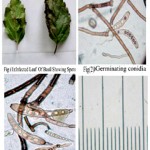How to Cite | Publication History | PlumX Article Matrix
Corynespora Blight of Sweet Basil : A New Disease from India
R. K. Vishwakarma1, V. K. Pal1* and M. Akhtar2
1Department of Botany Shibli National College, Azamgarh - 276 001 India.
2Shyama Sadan, 53/A, Paidleganj, Railway Colony, Gorakhpur - 273 012 India.
ABSTRACT: This paper deals with illustration, description and latin diagnosis concerned with Leaf Blight of Sweet Basil caused by Corynespora cassicola occurring on Rama Tulsi (Ocimum sanctum Linn.).
KEYWORDS: Sweet Basil; Corynespora; Blight
Download this article as:| Copy the following to cite this article: Vishwakarma R. K, Pal V. K, Akhtar M. Corynespora Blight of Sweet Basil : A New Disease from India. Biosci Biotech Res Asia 2011;8(2) |
| Copy the following to cite this URL: Vishwakarma R. K, Pal V. K, Akhtar M. Corynespora Blight of Sweet Basil : A New Disease from India. Biosci Biotech Res Asia 2011;8(2). Available from: https://www.biotech-asia.org/?p=9840 |
Introduction
During past few years, it has been taken into interest to describe new species of folïicoloushyphomycetous genus CorynesporaGüssow as pathogen causing leaf blight on a variety of plants from different parts of the India. After the establishment of the genus Corynespora a few species were described from different parts of the globe causing the leaf spot diseases on various host plants.
Our research efforts over the past 4 years have focused on the study related to the identification of the main diseases of the sweet basil through survey. Several fungal pathogens have been described on sweet basil, some are restricted to certain areas while others are more wide spread. Now a days, intensive cultivation of the crop favoured the outbreak of severe epidemics of some diseases and the appearance of new ones. Our recent survey of foliar fungi is based on the Basil Crop field in Azamgarh district. Here nursery of Basil is prepared in May-June and its plantation occurs in the month of July-August. Tulsi leaves are harvested in the month of November-December. The extensive survey of such crop fields resulted in a number of collections of living leaves of sweet Basil exhibiting Corynespora blight. No Corynespora species causing blight has yet been described on Sweet Basil in this region, as evident from the literature survey.
Material and Methods
Collection of specimens of leaf showing leaf blight were made at regular intervals from Basil crop fields of Azamgarh during crop season. Samples were collected and brought to the laboratory for microscopic examination and identification of causal organism. Scrape mounts were prepared in Lactophenol Cotton-blue mixture. The microphotographs of conidia and conidiophore and stage micrometer are also taken from slide with the help of an advanced camera at same magnification (Fig. 1 to 4).
 |
Figure 1
|
Morphotaxonomic description of causal organism
Corynesporacassicola (Berk& Curt.) Wei
Infection spots hypogenous becoming amphigenous later on, small to large, sub-circular to irregular, dark brown coloured spots which later become black in colour, 3-10 mm in diam. Colonies hypophyllous, effuse, brown. Mycelium internal and external, external hyphae septate, thin walled, smooth, branched, light brown.Stromata absent. Conidiophores macronematous, mononematous, arising singly from hyphae, straight to curved, simple, unbranched, multiseptate, upto 10 successive proliferations, pale to mid brown,120-710 x 5-10 mm in diam. Conidiogenous cells integrated, Monotretic, terminal, scars thickened. Conidia solitary to catenate, simple, cylindrical to obclavate, straight to curved, sub-hyaline to olivaceous brown, smooth, with 5-13 pseudosepta, 35-105 x 8-18 mm in diam; 4-7 mm wide at the truncate base. Germinating conidia with germ tubes are also observed.
Maculae hypogenae, posteriusamphigenae, sub-circularesvelirregulares, atrabrunneaevelatrae, 3-10 mm in diam. Coloniaehypophyllae, effusae, brunneae. Mycelium internumetexternum, ex hyphae externaeseptatae, tenuitunicatae, laeviae, ramosae, pallidebrunneae. Stromata absentia..Conidiophoramacronemata, mononemata, singularia, recta velflexuosa, non-ramosa, septata, usque 10 successive proliferati, pallidevelbrunneae, 120-710 x 5-10 mm in diam. Cellulaeconidiogenaeintegratae, monotreticae, terminals, cicatrices incrassatae. Conidia solitariavelcatenata, simplicïa, cylindricavelobclavata, recta velcurvata, sub-hyalinavelolivaceobrunneae, laevia, 5-13 distoseptata, 35-90 x 8-18 mm in diam., 4-7 mm lata ad basin truncata. Conidia germinalisnotata.
In foliisvivisOcimum sanctum Linn. (Lamiaceae) Organic India Crop Field, Azamgarh, U.P. India, 4 Dec. 2008 leg.; Rupesh Kumar Vishwakarma, S.N.C.A.F. Herb. No. RKV-5 (Holotype).
Discussion
Sweet basil is the native of India and an economically important medicinal plant in several Mediterranean countries. The area affected in Azamgarh, due to Corynesporablight of Sweet basil, experiences humid sub-tropical climatic conditions with high temperature rain fall and relative humidity. Foliar diseases thrive with high temperature, relative humidity and soil nitrogen. During the tenure of present study, approximately 75% of plants were found affected with dark brown coloured spots varying in distribution. Severe infection causes the wilting and outward rolling of leaves and plants look stunted. Corynespora blight affects the basil crop in both respect, quantitatively as well as qualitatively. The most important significance is the usage of infected plant leaves in which the chemical composition gets altered and even toxicant in preparation of herbal medicines. These can change the quality of the drugs with all probability. The observations of this work when brought to the awareness of the people of at least this region will certainly help in maintaining the quality and standard of the herbal drugs prepared by the professionals.
Acknowledgements
Authors are grateful to the Principal, Shibli National College, Azamgarh for providing facilities and to Prof. Kamal, Emeritus Scientist (DST) for helpful suggestions regarding the identity of the causal organism, in question.
References
- Ellis, M.B..DematiaceousHyphomycetes. CMI, Kew, U.K., pp. 608 (1971).
- Gupta, P.K., Sharma, N.D. and Gogoi, R. First Report of Sclerotiumrolfsi on Tulsi (Ocimum sanctum) from India.Indian Phytopath.61(3) : 370 (2008).
- Garibaldi, A., Gullino, M.L. and Minuto, G. Diseases of Basil and their management. Plant Disease, 81(2): 124-132 (1997).
- Jamaluddin, Goswami, M.G. and Ojha, B.M. Fungi of India (1989-2001). M/s. Scientific Publi., India, pp. 326 (2004).

This work is licensed under a Creative Commons Attribution 4.0 International License.





